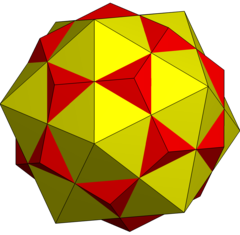| First stellation of icosidodecahedron | |
|---|---|

| |
| Type | Dual compound |
| Coxeter diagram | |
| Stellation core | icosidodecahedron |
| Convex hull | Rhombic triacontahedron |
| Index | W47 |
| Polyhedra | 1 icosahedron 1 dodecahedron |
| Faces | 20 triangles 12 pentagons |
| Edges | 60 |
| Vertices | 32 |
| Symmetry group | icosahedral (Ih) |
In geometry, this polyhedron can be seen as either a polyhedral stellation or a compound.
As a compound
editIt can be seen as the compound of an icosahedron and dodecahedron. It is one of four compounds constructed from a Platonic solid or Kepler-Poinsot solid, and its dual.
It has icosahedral symmetry (Ih) and the same vertex arrangement as a rhombic triacontahedron.
This can be seen as the three-dimensional equivalent of the compound of two pentagons ({10/2} "decagram"); this series continues into the fourth dimension as the compound of 120-cell and 600-cell and into higher dimensions as compounds of hyperbolic tilings.
A dodecahedron and its dual icosahedron |
The intersection of both solids is the icosidodecahedron, and their convex hull is the rhombic triacontahedron. |
The decagon on the right is the Petrie polygon of both solids.
As a stellation
editThis polyhedron is the first stellation of the icosidodecahedron, and given as Wenninger model index 47.
The stellation facets for construction are:
As a Faceting
editThe compound of a Dodecahedron and an Icosahedron shares the same vertices as a list of other polyhedra, including the Rhombic triacontahedron and the Small triambic icosahedron.
In popular culture
editIn the film Tron (1982), the character Bit took this shape when not speaking.
In the cartoon series Steven Universe (2013-2019), Steven's shield bubble, briefly used in the episode Change Your Mind, had this shape.
See also
editReferences
edit- Wenninger, Magnus (1974). Polyhedron Models. Cambridge University Press. ISBN 0-521-09859-9.